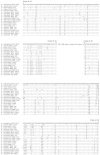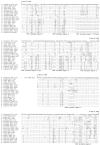Assessment of ribosomal large-subunit D1-D2, internal transcribed spacer 1, and internal transcribed spacer 2 regions as targets for molecular identification of medically important Aspergillus species
- PMID: 15872227
- PMCID: PMC1153785
- DOI: 10.1128/JCM.43.5.2092-2103.2005
Assessment of ribosomal large-subunit D1-D2, internal transcribed spacer 1, and internal transcribed spacer 2 regions as targets for molecular identification of medically important Aspergillus species
Abstract
Molecular approaches are now being developed to provide a more rapid and objective identification of fungi compared to traditional phenotypic methods. Ribosomal targets, especially the large-subunit RNA gene (D1-D2 region) and internal transcribed spacers 1 and 2 (ITS1 and ITS2 regions), have shown particular promise for the molecular identification of some fungi. We therefore conducted an assessment of these regions for the identification of 13 medically important Aspergillus species: Aspergillus candidus, Aspergillus (Eurotium) chevalieri, Aspergillus (Fennellia) flavipes, Aspergillus flavus, Aspergillus fumigatus, Aspergillus granulosus, Aspergillus (Emericella) nidulans, Aspergillus niger, Aspergillus restrictus, Aspergillus sydowii, Aspergillus terreus, Aspergillus ustus, and Aspergillus versicolor. The length of ribosomal regions could not be reliably used to differentiate among all Aspergillus species examined. DNA alignment and pairwise nucleotide comparisons demonstrated 91.9 to 99.6% interspecies sequence identities in the D1-D2 region, 57.4 to 98.1% in the ITS1 region, and 75.6 to 98.3% in the ITS2 region. Comparative analysis using GenBank reference data showed that 10 of the 13 species examined exhibited a < or = 1-nucleotide divergence in the D1-D2 region from closely related but different species. In contrast, only 5 of the species examined exhibited a < or = 1-nucleotide divergence from sibling species in their ITS1 or ITS2 sequences. Although the GenBank database currently lacks ITS sequence entries for some species, and major improvement in the quality and accuracy of GenBank entries is needed, current identification of medically important Aspergillus species using GenBank reference data seems more reliable using ITS query sequences than D1-D2 sequences, especially for the identification of closely related species.
Figures


Similar articles
-
Molecular methods for the identification of Aspergillus species.Med Mycol. 2005 May;43 Suppl 1:S129-37. doi: 10.1080/13693780500064722. Med Mycol. 2005. PMID: 16110805
-
Comparison of sequencing the D2 region of the large subunit ribosomal RNA gene (MicroSEQ®) versus the internal transcribed spacer (ITS) regions using two public databases for identification of common and uncommon clinically relevant fungal species.J Microbiol Methods. 2017 Sep;140:40-46. doi: 10.1016/j.mimet.2017.06.015. Epub 2017 Jun 21. J Microbiol Methods. 2017. PMID: 28647582
-
Rapid differentiation of Aspergillus species from other medically important opportunistic molds and yeasts by PCR-enzyme immunoassay.J Clin Microbiol. 2004 Aug;42(8):3495-504. doi: 10.1128/JCM.42.8.3495-3504.2004. J Clin Microbiol. 2004. PMID: 15297489 Free PMC article.
-
PCR detection of aflatoxin producing fungi and its limitations.Int J Food Microbiol. 2012 May 1;156(1):1-6. doi: 10.1016/j.ijfoodmicro.2012.03.001. Epub 2012 Mar 7. Int J Food Microbiol. 2012. PMID: 22445201 Review.
-
Utilization of the internal transcribed spacer regions as molecular targets to detect and identify human fungal pathogens.Med Mycol. 2002 Feb;40(1):87-109. doi: 10.1080/mmy.40.1.87.109. Med Mycol. 2002. PMID: 11860017 Review.
Cited by
-
Mycofier: a new machine learning-based classifier for fungal ITS sequences.BMC Res Notes. 2016 Aug 11;9(1):402. doi: 10.1186/s13104-016-2203-3. BMC Res Notes. 2016. PMID: 27516337 Free PMC article.
-
Aspergillus species identification in the clinical setting.Stud Mycol. 2007;59:39-46. doi: 10.3114/sim.2007.59.05. Stud Mycol. 2007. PMID: 18490954 Free PMC article.
-
Granulomatous polyarthritis caused by Talaromyces georgiensis in a dog.J Vet Diagn Invest. 2020 Nov;32(6):912-917. doi: 10.1177/1040638720957964. Epub 2020 Oct 1. J Vet Diagn Invest. 2020. PMID: 33000702 Free PMC article.
-
Molecular genotyping, diversity studies and high-resolution molecular markers unveiled by microsatellites in Giardia duodenalis.PLoS Negl Trop Dis. 2018 Nov 30;12(11):e0006928. doi: 10.1371/journal.pntd.0006928. eCollection 2018 Nov. PLoS Negl Trop Dis. 2018. PMID: 30500829 Free PMC article.
-
Characterization of Microbial Diversity of Two Tomato Cultivars through Targeted Next-Generation Sequencing 16S rRNA and ITS Techniques.Microorganisms. 2023 Sep 18;11(9):2337. doi: 10.3390/microorganisms11092337. Microorganisms. 2023. PMID: 37764180 Free PMC article.
References
-
- Accensi, F., J. Cano, L. Figuera, M. L. Abarca, and F. J. Cabanes. 1999. New PCR method to differentiate species in the Aspergillus niger aggregate. FEMS Microbiol. Lett. 180:191-196. - PubMed
-
- Buzina, W., H. Braun, K. Freudenschuss, A. Lackner, W. Habermann, and H. Stammberger. 2003. Fungal biodiversity—as found in nasal mucus. Med. Mycol. 41:149-161. - PubMed
Publication types
MeSH terms
Substances
LinkOut - more resources
Full Text Sources
Other Literature Sources
Molecular Biology Databases

